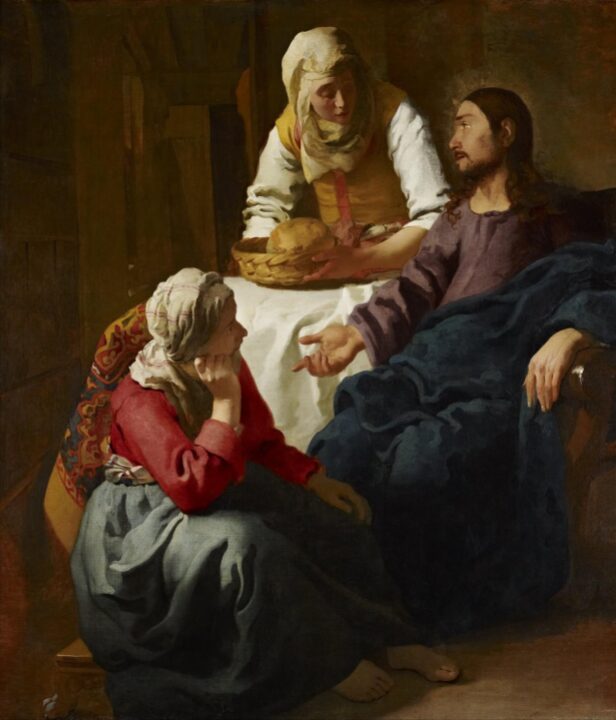As I was thinking about our theme that love accepts, I thought about 1 Corinthians 13.
So, I started reading that in different versions of the Bible. The one I particularly liked, the version out of the Amplified Bible, I’d like to talk about it. 1 Corinthians 13 is often a scripture that we read at weddings because it defines love.
But you know, it was written for the church in Corinth, that couldn’t get along. It was written for a church that picked fights with itself and blamed each other for issues. Paul wrote this to remind them of who they were meant to be.
Love bears all things [regardless of what comes], believes all things [looking for the best in each one], hopes all things [remaining steadfast during difficult times], endures all things [without weakening].
– 1 Corinthians 13 (Amplified Bible)
What I liked about the amplified version is what it put in the parentheses, or brackets, it added text in brackets. I think that’s powerful. I think this leads us to important questions.
What happens if we accept all things as they are rather than judging them for what they are not?
Accepting all things doesn’t mean approving all things. You can accept, but is doesn’t mean you need to like it. It doesn’t mean you need to approve or condone it, but you can accept it and let it be what it is. Respect what it is, even if you don’t understand it. It does mean giving ourselves and others grace and accepting our own limitations because we may need to accept what is true about us.
Today’s scripture from Luke could be called a tale of two sisters.
First we have Martha. It just tells us that they’re sisters, but everybody has a perception that Martha is older. It’s very interesting. It sort of makes sense based on how the story plays out. Older sisters or firstborn have a tendency to be rule followers. They have a tendency to be very dutiful. They’re people pleasers. They understand the cultural expectations on them. Martha being a female in this culture understood that when 13 people show up at her house, without invitation, then she needs to provide hospitality.
Hospitality looks like having some kind of food and beverages, so somebody needs making start making pitas and somebody better grind up some hummus because we got 13 extra people at the table. That, I think, was Martha’s mindset.
Then there’s Mary. Mary is generally perceived as being younger, something about younger children or the baby of the family, they tend to be more playful. They tend to be a little bit more self involved or self interested. They’re going to make sure their needs are met. It’s not always true, I’m talking in generalizations, but the baby tends to behave differently in a situation.
So, here are these two sisters. Martha goes to work in the kitchen. She’s about feeding everybody. Mary sits down in the living room and decides to listen. Actually, what happens in this is perfect example of triangulation. Martha is mad at Mary, but instead of talking to Mary, she talks to Jesus.

But in this version by Vermeer, what I love is you can’t tell the differences in age. Vermeer has Jesus look at Martha and gesture to Mary as if he is trying to connect them. He hears Martha, but he acknowledges Mary. Like there’s not, there’s not a, a right and wrong. Somebody needs to make dinner, but somebody needs to listen to what Jesus has to say.
Both roles are important. There’s not a good versus bad. There’s not a victim perpetrator. They’re both appropriate. Jesus kind of tries to smooth that through. That’s what Vermeer is trying to show.
I also really like this picture because that is not what I think we expect Jesus to look like. First of all, he looks very Jewish, but he doesn’t look like a savior. He doesn’t look like the superstar. This isn’t a Jesus that you’re going to say, Oh, wow. I want to see that guy. I think that just challenges us a little bit about Jesus.
But I thought about this story in the larger context of Luke, and I thought it’d be very interesting, and I think it’s a good short study for us to compare this story with the parable of the Good Samaritan because this comes immediately after the parable.
When writers put things like that together, it’s good to step back and say, are we supposed to learn something from this? Is there a deeper meaning in the fact that these are put together?
I’m not going to read the Good Samaritan story to us, but think back to the parable of the Good Samaritan. Does anybody remember what the problem was? What was the issue that needed to be addressed in the Good Samaritan? There was an injured man laying by the side of the road who needed help. What do the Levite and the priest do? Does anybody remember what they do? They walk away. They choose not to engage. Their attention is somewhere else. They say they crossed to the other side of the road and kept going.
It sounds like they saw it. There’s good reasons for a priest not to touch an injured body, especially if there’s blood obvious, because if he touches blood, then he is unclean. It’s like having COVID for a week, he has to seclude himself and do all of this ritual cleansing thing till he can go back to work. So it’s easier if he doesn’t get involved.
What does the Samaritan do? He takes him to a hotel. He takes care of the mans wounds and pays someone to continue to care for him for two days. He gives him two days wages to take care of them and says, if it costs you more than that, I’ll even pay that. So he provides all the care.
Now let’s go back to today’s story.
Where was Martha’s attention? Martha’s attention was in the kitchen. There was stuff to be done. I do know what I would do if 13 people showed up. That used to happen when the kids were little, right? Suddenly my yard is full of kids and guess what? Somebody’s hungry, which if somebody’s hungry, everybody’s hungry and everybody needs snack. That’s just what you do. You just start pulling out snacks and you bought them at BJ’s in bulk and here they are. Today’s snack is cheese doodles.
What’s Mary doing? Where’s Mary’s focus? Jesus. Mary’s focus is on the guest, right? Mary is also doing hospitality, but she is doing hospitality for the person. She’s not involved in all of the other things. She’s involved in listening. She knows that there is something to be learned here. It’s not really clear whether Mary and Martha knew Jesus and the disciples before they walked in, except that the way Martha talks to him, I don’t think you would get involved in that kind of a conversation unless you already knew the person. Mary may even be taking care of her own spiritual needs.
But for me, it’s the issues are Where Is Their Attention?

In the good Samaritan the Levite and the priest, their attention is on themselves. I feel like that’s Martha. Martha knows there’s food to be made. She’s gotta be in the kitchen taking care of stuff.
Whereas I put the Samaritan and Mary together because the Samaritan wants to care for the person and Mary. Is giving her attention to the guest, specifically Jesus. The attention is to the guest to listening to the guests, to making sure the guest feels welcomed in that respect. Probably knowing that she’s going to learn something there.
What about perceptions? What about the perception of the Levite and the priest? The perception of Martha? Does anybody see any ties there? How those could be similar in my mind? I’ll give you my logic again. They’re tied up with what has to be done with the doing. Whereas the Samaritan and Mary are about being. The Samaritan does do also, right? The Samaritan, because he helps, he bandages the wounds and he takes the guys. So there’s some doing in there. But I think there’s a difference in perception.
I think that it reminds us that we’re to look at how we can be accepting and maybe even let go of some of the perceptions that we have of other people.
The Levite and the priest may have had a perception of the person at the side of the road. They were beyond help or maybe that’s something they see all the time. It’s almost like another dead guy to walk around. Isn’t that sad? We don’t want to get to that point. We don’t want to get to the point where we look at something and go, “there they go again. That’s just them acting out again.”
We want to be able to actually look at people and care about them, see their need, see them for who they are, not for our perception of who they are.
Because our perceptions are all based on the stories we write in our minds. Our stories always agree with the judgments we have made. That’s why there are rationalizations. We can rationalize anything. All we need is a good story and our brain, our ego will supply it. But here’s the thing to remember about perceptions. Perceptions are usually or often wrong.
Mic drop. Our perceptions are usually wrong. They may be based on old wisdom. They may be based on bad information, inaccurate information that we have gotten along the way. So we need to pay attention and we need to recognize that we can choose to let go of those perceptions. That is a choice. That is a choice that is ours.
I hope that you can take some wisdom today from Simon and Garfunkel. Slow down. You move too fast. You got to make the morning last.



